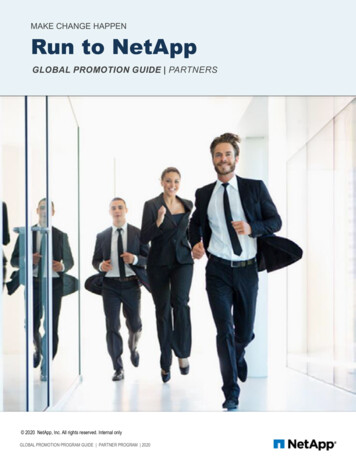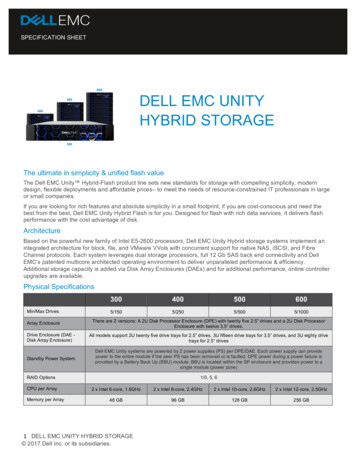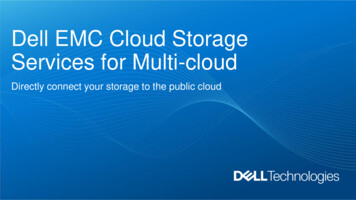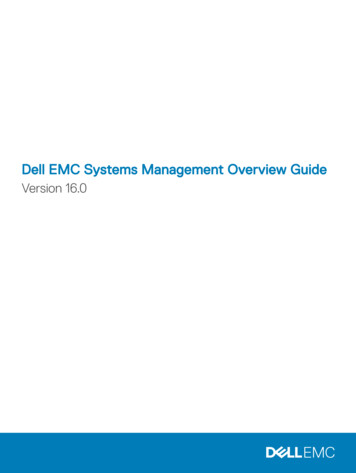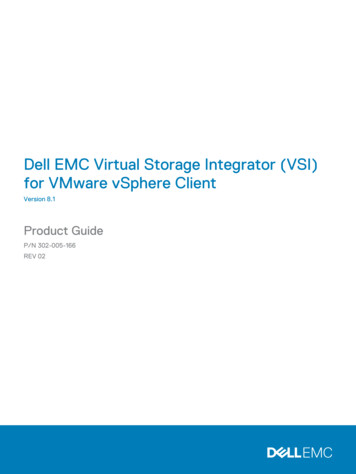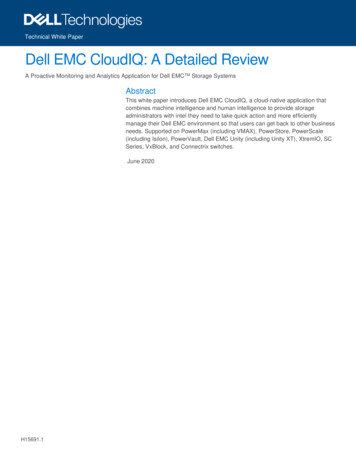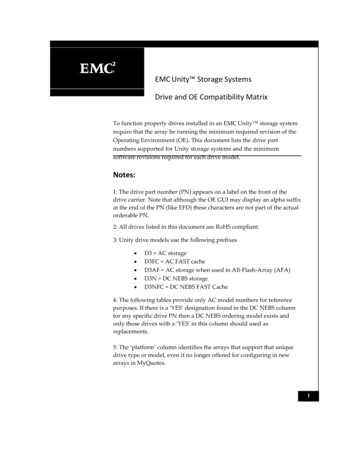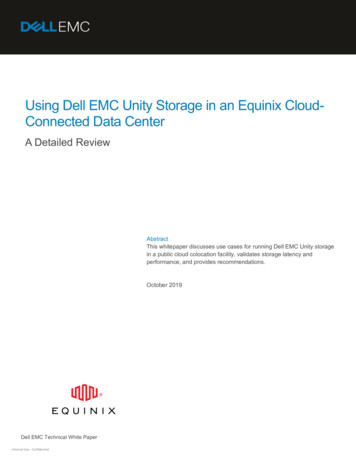
Transcription
Using Dell EMC Unity Storage in an Equinix CloudConnected Data CenterA Detailed ReviewAbstractThis whitepaper discusses use cases for running Dell EMC Unity storagein a public cloud colocation facility, validates storage latency andperformance, and provides recommendations.October 2019Dell EMC Technical White PaperInternal Use - Confidential
RevisionsVersionDateDescription0.01February 2019Initial draft0.18May 2019Updated to include Microsoft Azure0.24October 2019Minor editsAcknowledgementsThis paper was produced by the following members of the Dell EMC Presales team:Author: Ryan TassottiThis whitepaper was possible thanks to the contributions from: Rajiv JunejaAlex SeymourGabriel LageyreLee SharpingMischa JampolskyDell EMCDell EMCEquinixEquinixEquinixThe information in this publication is provided “as is.” Dell Inc. makes no representations or warranties of any kind with respect to the information in thispublication, and specifically disclaims implied warranties of merchantability or fitness for a particular purpose.Use, copying, and distribution of any software described in this publication requires an applicable software license. 2019 Dell Inc. or its subsidiaries. All Rights Reserved. Dell, EMC, Dell EMC and other trademarks are trademarks of Dell Inc. or its subsidiaries. Othertrademarks may be trademarks of their respective owners.Equinix, Platform Equinix, and IBX are registered trademarks of Equinix, Inc. Equinix Cloud Exchange Fabric, ECX Fabric, and Equinix InternationalBusiness Exchange are trademarks of Equinix, Inc.Dell believes the information in this document is accurate as of its publication date. The information is subject to change without notice.2Using Dell EMC Unity Storage in an Equinix Cloud-Connected Data CenterInternal Use - Confidential
Table of contentsRevisions.2Acknowledgements .2Executive summary.4123456AThe Case for Storage in a Cloud-Connected Colocation Facility.51.1Use Cases .51.2Why Validate by Testing? .5Amazon Web Services Architecture and Testing .62.1Architecture.62.2AWS Testing Configuration .62.3The Tests .9Amazon Web Services Testing Results .143.1Windows Disk Benchmarking Results .143.2Windows SQL Benchmarking Results .163.3Linux Disk Benchmarking Results .173.4Linux Oracle Benchmarking Results .193.5Unity performance observations .19Microsoft Azure Architecture and Testing .224.1Architecture.224.2Azure Testing Configuration .224.3The Tests .25Microsoft Azure Testing Results.275.1Windows Disk Benchmarking Results .275.2Windows SQL Benchmarking Results .29Conclusion .306.1Observations.306.2Recommendations .306.3Calls to action .30Technical support and resources .31A.13Related resources .31Using Dell EMC Unity Storage in an Equinix Cloud-Connected Data CenterInternal Use - Confidential
Executive summaryFor some customers, public cloud infrastructure has changed the way they deploy, manage and consume IT.For other customers, public cloud is something that should be explored, because it has the potential to be asuitable location for some of their workloads. However, having workloads in the public cloud can raise issuesthat are not applicable to an on-premises architecture, such as: Data sovereignty: Where is my data stored, and who has access to it?Cost predictability: What are my future public cloud charges?Performance predictability: How do I maintain consistent performance?Generally speaking, the public cloud conversation will discuss taking a customer’s on premises workload(including compute and storage) and moving it in its entirety into a public cloud provider’s infrastructure, whichcan raise the above issues for some customers. The purpose of this whitepaper is to validate an alternativeapproach, which is to take advantage of the compute benefits that public cloud provides, while addressing theaforementioned issues by housing the customer’s data holdings on a Dell EMC Unity storage array in a publiccloud colocation facility, such as an Equinix Cloud-Connected Data Center.This whitepaper will outline use cases for public cloud compute instances connecting to a Dell EMC Unitystorage array in an Equinix facility, compare storage latency and performance for both public cloud storageand Unity storage, and provide recommendations.4Using Dell EMC Unity Storage in an Equinix Cloud-Connected Data CenterInternal Use - Confidential
1The Case for Storage in a Cloud-Connected ColocationFacilityWhen it comes to cloud infrastructure, there are 3 commonly used architectures: Private cloud (on premises): The customer’s workloads run on onsite infrastructure.Public cloud: The customer’s workloads are housed offsite.Hybrid cloud: Some of the customer’s workloads are in public cloud, and some workloads are intheir onsite private cloud.There is also mixed architecture, where for a given set of workloads, a customer will have their computeinstances in public cloud, and their data (storage) housed in a public cloud-connected colocation facility, suchas an Equinix Cloud-Connected Data Center.1.1Use CasesThere are four broad use case categories which describe why a public cloud compute customer would want tohave their data at rest in a public cloud-connected colocation facility: 1.25Data sovereignty: A customer wants to take advantage of the economics of public cloudcompute services and application, however is mandated to keep data stored within ageographical location.Disaster recovery: A customer has an on-premises storage array and wants to create a disasterrecovery capability by performing storage replication to an offsite storage array. If this offsitestorage array is hosted in a public cloud-connected colocation facility, then public cloud computeinstances can be spun up and attached to the offsite storage replica(s) in a disaster recoveryscenario.Predictable TCO: Storage can be the highest cost component of public cloud. Hosting a storagearray in a public cloud-connected colocation facility provides a fixed cost for storage, whileleveraging public cloud compute services and applications.Storage performance: Some deployed data center workloads such as databases requireconsistent low latencies from the storage system, to ensure a predictable user experience.Hosting a storage array in a public cloud-connected colocation facility provides more consistentand lower storage latencies than public cloud storage.Why Validate by Testing?Many customers using an on premises private cloud architecture run workloads that are sensitive to bothstorage latency and performance, a good example being databases. If a customer has an OLTP databaseworkload that is important to their business or operation, the probability that this customer expects consistentlow storage latency and predictable performance is high.Using Dell EMC Unity Storage in an Equinix Cloud-Connected Data CenterInternal Use - Confidential
2Amazon Web Services Architecture and TestingThis section will outline the Amazon Web Services (AWS) architecture as tested, and detail the testsperformed.2.1ArchitectureThe high-level architecture is presented in Figure 1. The architecture consists of: Dell EMC Unity storage array, residing in a public cloud-connected colocation facility (Equinix);Dell EMC 10Gb networking switch, also in a public cloud-connected colocation facility (Equinix);10Gb AWS Direct Connect IP network link between colocation-connected facility and AWS publiccloud;EC2 compute instances in AWS that connect to the Dell EMC Unity storage array.High level AWS architecture as tested2.2AWS Testing ConfigurationThis section will outline the as-tested configuration of the AWS EC2 instances, the AWS EBS volumes, theAWS Direct Connect network link, the Dell EMC Unity storage array, and the Dell EMC network switch.Note: All AWS resources (EC2, EBS, etc.) were deployed in the Asia Pacific (Sydney) Region, specifically theap-southeast-2a Availability Zone. The Dell EMC resources (Unity storage array, network switch) weredeployed at an Equinix International Business Exchange (IBX ) facility in Sydney.2.2.1AWS EC2 Windows InstanceThe features of the chosen Amazon EC2 Windows instance are as follows: 6m4.4xlarge Instance typeMicrosoft Windows Server 2016 with SQL Server 2016 Standard64 GiB memory16 vCPUsUsing Dell EMC Unity Storage in an Equinix Cloud-Connected Data CenterInternal Use - Confidential
2.2.2Enhanced NetworkingEBS-Optimized storageJumbo frames is enabledAWS EC2 Linux InstanceThe features of the chosen Amazon EC2 Linux instance are as follows: 2.2.3m4.4xlarge Instance typeOracle Linux 7 Update 6 (x86 64)64 GiB memory16 vCPUsEnhanced NetworkingEBS-Optimized storageJumbo frames is enabledAWS EBS VolumesThe EBS Volumes for attaching to the Windows EC2 instance were created and configured as follows: One (1) 30 GiB General Purpose SSD (gp2) volume was configured as the C: driveThis was included as part of the m4.4xlarge instance deploymentNot encryptedFive (5) 30 GiB General Purpose SSD (gp2) volumes were presented to the host, and a singlesoftware RAID5 volume was created, mounted as the D: driveNot encryptedThe EBS Volumes for attaching to the Linux EC2 instance were created and configured as follows: One (1) 30 GiB General Purpose SSD (gp2) volume was configured as the /root volumeThis was included as part of the m4.4xlarge instance deploymentNot encryptedFive (5) 30 GiB General Purpose SSD (gp2) volumes were presented to the host, and a singlesoftware RAID5 device was created, mounted as /home/oracle/raid5.Not encryptedSeveral additional General Purpose SSD (gp2) volumes were presented to the host for the Oracle installation,as per Oracle best practice. No performance tests were run against these volumes, and these volumes werenot encrypted.Note: AWS EBS General Purpose SSD (gp2) volumes have the concept of IO burst credits, which is coveredin detail here. In summary, EBS gp2 volumes will perform at a minimum of 3 IOPS per GiB and will burst up to3,000 IOPS per volume if in credit. For all tests performed against and results given for EBS volumes inthis whitepaper, the EBS volumes were wholly using burst credits, i.e. the EBS volumes were nevertested at their minimum stated performance of 3 IOPS per GiB. It is for this reason that each test iteration wasonly run for several minutes and were spaced over a 24-hour period.7Using Dell EMC Unity Storage in an Equinix Cloud-Connected Data CenterInternal Use - Confidential
2.2.4AWS Direct ConnectWhen in an Equinix facility, there are two ways to connect the co-located Unity storage array to the AWS EC2compute instances: Equinix Cloud Exchange Fabric (ECX Fabric ); orAWS Direct ConnectEquinix Cloud Exchange FabricThe major benefit of connecting into public cloud compute via the Equinix Cloud Exchange Fabric is that all ofthe network links into public cloud providers (Amazon AWS, Microsoft Azure, Google Cloud Platform, andAlibaba Cloud) are handled by a single connection out of the customer’s co-located equipment. So, forexample, the Unity storage array connects to a network switch in the same rack, and it is this network switchthat connects once to the Equinix Cloud Exchange Fabric. From there, connections to the required publiccloud providers are established and managed by Equinix. More information can be found here.“ECX Fabric brings together cloud service providers and users, enabling them to establish affordable,private, high-performance connections within Platform Equinix ” (Equinix).AWS Direct ConnectTo establish a private connection between AWS and the Unity storage array, the customer engages withAWS via the AWS Console to procure a Direct Connect connection. More information can be found here.“Using AWS Direct Connect, you can establish private connectivity between AWS and your datacenter,office, or colocation environment, which in many cases can reduce your network costs, increasebandwidth throughput, and provide a more consistent network experience than Internet-basedconnections.” (Amazon)For the purposes of this testing, an AWS Direct Connect network link was established. Direct Connect routingwas provided by Equinix.The features of the AWS Direct Connect network link as configured are as follows: Port Speed is 10GbpsJumbo Frame Capable is trueLocation is Equinix SY1 – SY4, Sydney, AUSThe features of the associated Virtual Interface as configured are as follows: 2.2.5Type is privateJumbo Frame Capable is trueMTU is 9001Dell EMC Unity StorageDeliver consistent high performance for workloads with Dell EMC Unity storage. Dell EMC Unity brings youhigh performance and low latency across a broad range of SAN and NAS use cases.Dell EMC Unity redefines simple, modern, affordable, and flexible primary storage. Its modern architecture isdesigned for flash and unified data services, in a footprint starting at 2U. High-density SSD technology andinline data reduction adds to performance and value.8Using Dell EMC Unity Storage in an Equinix Cloud-Connected Data CenterInternal Use - Confidential
This unified storage comes standard with support for file and block, point-in-time snapshots, local and remotedata replication, and built-in encryption. You’ll also have deep integration with VMware, Microsoft, andOpenStack ecosystems. Dell EMC Unity is also available as a virtual appliance (Dell EMC UnityVSA), and inthe public cloud (Dell EMC Unity Cloud Edition).Ongoing operation is simple with proactive assistance and automated remote support. Gain intelligent insightinto your storage health with CloudIQ, which provides cloud-based proactive monitoring and predictiveanalytics. More information can be found here.The configuration of the tested Dell EMC Unity storage array is as follows: 2.2.6Dell EMC Unity 400 hybrid storage arrayDell EMC Unity OE version 4.4.1.15393098792 x 400GB SSDsConfigured as RAID 1 1NFS share- NFS v3- 75GB size- Mounted as /home/oracle/nfs on the Linux hostSMB share- SMB v3- 75GB size- Mounted as Y: drive on the Windows hostJumbo frames enabled2 rack unitsDell EMC Network SwitchThe S4148F-ON network switch is a one rack unit (RU), full-featured fixed form-factor top-of-rack (ToR)10/25/40/50/100GbE switch for 10G servers with small form-factor pluggable plus (SFP ), quad small formfactor pluggable plus (QSFP ), and quad small form-factor pluggable (QSFP28) ports.Dell EMC Networking OS10 Enterprise Edition is a network operating system (OS) supporting multiplearchitectures and environments. The networking world is moving from a monolithic stack to a pick-your-ownworld. The OS10 solution allows disaggregation of the network functionality. More information can be foundhere.The configuration of the tested network switch is as follows: 2.3The TestsThere are four test categories used to validate the viability of the Dell EMC Unity solution in an Equinix facility: 9Model: S4148F-ONOS version: 10.4.2.0Connectivity to Unity storage array: 10Gb TwinAxConnectivity to Direct Connect router: 10Gb LR SFP 1 rack unitJumbo frames enabledWindows disk benchmarkingUsing Dell EMC Unity Storage in an Equinix Cloud-Connected Data CenterInternal Use - Confidential
2.3.1Windows SQL benchmarkingLinux disk benchmarkingLinux Oracle benchmarkingWindows Disk BenchmarkingTo test disk latency and performance, the Microsoft tool diskspd is installed on the AWS EC2 Windowsinstance. The version used is 2.0.17, and the tool is available here.“A feature-rich and versatile storage testing tool, Diskspd combines robust and granular IO workloaddefinition with flexible runtime and output options, creating an ideal tool for synthetic storage subsystemtesting and validation.” (Microsoft)The four tests that are performed as part of Windows disk benchmarking are: 100% read, random, 8KB IO sizediskspd.exe -b8k -c1G -t4 -r -o4 -d120 -Sh -ft -L -w0diskspd.exe -b8k -c1G -t4 -r –o16 -d120 -Sh -ft -L -w0 100% write, random, 8KB IO sizediskspd.exe -b8k -c1G -t4 -r -o4 -d120 -Sh -ft -L -Z1G -w100diskspd.exe -b8k -c1G -t4 -r –o16 -d120 -Sh -ft -L -Z1G -w100 75/25% read/write, random, 8KB IO sizediskspd.exe -b8k -c1G -t4 -r -o4 -d120 -Sh -ft -L -Z1G -w25diskspd.exe -b8k -c1G -t4 -r –o16 -d120 -Sh -ft -L -Z1G -w25 100% read, sequential, 8KB IO sizediskspd.exe -b8k -c1G -t4 -si -o4 -d120 -Sh -ft -L -w0diskspd.exe -b8k -c1G -t4 -si –o16 -d120 -Sh -ft -L -w0Note: There are two iterations of each test run. The first iteration sets the number of outstanding IOs at 4(-o4). The second iteration sets the number of outstanding IOs at 16 (-o16).Additional notes about these tests and results: 10Each test iteration is run five times against each storage type, at various times throughout a 24hour period.Each test iteration is run for two minutes.The results presented are averaged (Results are added then divided by five).Two sets of results are produced for each test iteration: Latency and IOs.Latency figures given are for the 99th percentile.IOs figure given is the average number of IOs transferred over the two-minute period.Using Dell EMC Unity Storage in an Equinix Cloud-Connected Data CenterInternal Use - Confidential
2.3.2Windows SQL BenchmarkingTo test synthetic SQL database performance, the open source tool HammerDB is installed on the AWS EC2Windows instance. The version used is 3.1, and the tool is available here.“HammerDB is the leading benchmarking and load testing software for the world’s most populardatabases supporting Oracle Database, SQL Server, IBM Db2, MySQL, MariaDB, PostgreSQL andRedis.” (HammerDB)Notes about this test and results: 2.3.3The SQL version is 2017.Warehouses created is 16.Virtual users is 16.Warm up time is 2 mins.Run time is 10 mins.Each test is run five times against each storage type, at various times throughput a 24-hourperiod.The results presented are averaged (Results are added then divided by five).The results given are Transactions per Minute (TPM).No database-tuning was performed.Linux Disk BenchmarkingTo test disk latency and performance, the open source tool fio is installed on the AWS EC2 Linux instance.The version used is 2.0.9, and the tool is available here.“Fio was written by Jens Axboe axboe@kernel.dk to enable flexible testing of the Linux I/O subsystemand schedulers. He got tired of writing specific test applications to simulate a given workload, and foundthat the existing I/O benchmark/test tools out there weren't flexible enough to do what he wanted.”(Github)The four tests that are performed as part of Linux disk benchmarking are: 100% read, random, 8KB IO sizefio --name randread --ioengine libaio --iodepth 4 --rw randread --bs 8k --direct 1 -size 2048m --numjobs 4 --runtime 120 --group reporting --time basedfio --name randread --ioengine libaio --iodepth 16 --rw randread --bs 8k --direct 1 -size 2048m --numjobs 4 --runtime 120 --group reporting --time based 100% write, random, 8KB IO sizefio --name randwrite --ioengine libaio --iodepth 4 --rw randwrite --bs 8k --direct 1 -size 2048m --numjobs 4 --runtime 120 --group reporting --time basedfio --name randwrite --ioengine libaio --iodepth 16 --rw randwrite --bs 8k --direct 1 -size 2048m --numjobs 4 --runtime 120 --group reporting --time based 1175/25% read/write, random, 8KB IO sizeUsing Dell EMC Unity Storage in an Equinix Cloud-Connected Data CenterInternal Use - Confidential
fio --name randrw --ioengine libaio --iodepth 4 --rw randrw --bs 8k --direct 1 --size 2048m--numjobs 4 --runtime 120 --group reporting --time based --rwmixread 75fio --name randrw --ioengine libaio --iodepth 16 --rw randrw --bs 8k --direct 1 -size 2048m --numjobs 4 --runtime 120 --group reporting --time based --rwmixread 75 100% read, sequential, 64KB IO sizefio --name seqread --ioengine libaio --iodepth 4 --rw read --bs 64k --direct 1 --size 2048m--numjobs 4 --runtime 120 --group reporting --time basedfio --name seqread --ioengine libaio --iodepth 16 --rw read --bs 64k --direct 1 -size 2048m --numjobs 4 --runtime 120 --group reporting --time basedNote: There are two iterations of each test run. The first iteration sets the number of outstanding IOs at 4(--iodepth 4). The second iteration sets the number of outstanding IOs at 16 (--iodepth 16).Additional notes about these tests and results: 2.3.4Each test iteration is run five times against each storage type, at various times throughout a 24hour period.Each test iteration is run for two minutes.The results presented are averaged (Results are added then divided by five).Two sets of results are produced for each test iteration: Latency and throughput:Latency figures given are for the 99th percentile.Throughput figures given are the average number of MBs transferred over the two-minute period.Linux Oracle BenchmarkingTo test synthetic Oracle database performance, the Oracle tool ORION (ORacle IO Numbers) is installed onthe AWS EC2 Linux instance. ORION is included with the Oracle installation, the version used is 12.2.0.1.0,and more information about the tool is here.“Oracle Orion is a tool for predicting the performance of an Oracle database without having to installOracle or create a database. Unlike other I/O calibration tools, Oracle Orion is expressly designed forsimulating Oracle database I/O workloads using the same I/O software stack as Oracle. Orion can alsosimulate the effect of striping performed by Oracle Automatic Storage Management.” (Oracle)The test that is performed, when in the applicable storage subdirectory, is: OLTP, 8KB IO sizeorion -run oltp -testname storage name -hugenotneeded -cache size 012Using Dell EMC Unity Storage in an Equinix Cloud-Connected Data CenterInternal Use - Confidential-num disks 15
Additional notes about these tests and results: 13ORION tests with random small (8K) IOs at increasing loads to determine the maximum IOPS ofthe storage it is run against. So eventually at a certain data point, the maximum IOPS for thatstorage subsystem is reached, and the latency observed at that data point is recorded.Each test is run until completed.IOPS figure given is the maximum as recorded by ORION.Latency figure given is at the maximum IOPS figure as recorded by ORION.Using Dell EMC Unity Storage in an Equinix Cloud-Connected Data CenterInternal Use - Confidential
3Amazon Web Services Testing ResultsThis section provides the results for disk and application benchmarking for AWS EBS storage and Dell EMCUnity storage.3.1Windows Disk Benchmarking ResultsThe latency results with outstanding IOs set to 4 are presented in Table 1. Lower numbers are better.4540Latency (ms)35302520Local EBS GP215Local EBS GP2 RAID510Unity CIFS (Equinix)50100% random read 100% random write 75%/25% random 75%/25% random 100% sequential8K latency8K latencyread/write 8K read read/write 8K write read 8K latencylatencylatencyDiskspd TestsDiskspd latency observed at host with outstanding IOs 4The latency results with outstanding IOs set to 16 are presented in Table 2. Lower numbers are better.4540Latency (ms)35302520Local EBS GP215Local EBS GP2 RAID510Unity CIFS (Equinix)50100% random read 100% random write 75%/25% random 75%/25% random 100% sequential8K latency8K latencyread/write 8K read read/write 8K write read 8K latencylatencylatencyDiskspd TestsDiskspd latency observed at host with outstanding IOs 1614Using Dell EMC Unity Storage in an Equinix Cloud-Connected Data CenterInternal Use - Confidential
The IOPS results with outstanding IOs set to 4 are presented in Table 3. Higher numbers are better.4,000,000IOs over 120 secs3,500,0003,000,0002,500,0002,000,000Local EBS GP21,500,000Local EBS GP2 RAID51,000,000Unity CIFS (Equinix)500,0000100% randomread 8K IOS100% random 75%/25% random 75%/25% random 100% sequentialwrite 8K IOSread/write 8Kread/write 8Kread 8K IOSread IOSwrite IOSDiskspd TestsDiskspd IOs transferred with outstanding IOs 4The IOPS results with outstanding IOs set to 16 are presented in Table 4. Higher numbers are better.4,000,000IOs over 120 secs3,500,0003,000,0002,500,0002,000,000Local EBS GP21,500,000Local EBS GP2 RAID51,000,000Unity CIFS (Equinix)500,0000100% randomread 8K IOS100% random 75%/25% random 75%/25% random 100% sequentialwrite 8K IOSread/write 8Kread/write 8Kread 8K IOSread IOSwrite IOSDiskspd TestsDiskspd IOs transferred with outstanding IOs 1615Using Dell EMC Unity Storage in an Equinix Cloud-Connected Data CenterInternal Use - Confidential
3.2Windows SQL Benchmarking ResultsThe synthetic SQL benchmarking results are presented in Table 5. Higher numbers are better.HammerDB w/MSSQL, Transactions per minute ,000100,00050,0000EBS LocalEBS Raid 5TPMHammerDB Transactions per Minute16Using Dell EMC Unity Storage in an Equinix Cloud-Connected Data CenterInternal Use - ConfidentialUnity CIFS (Equinix)
3.3Linux Disk Benchmarking ResultsThe latency results with outstanding IOs set to 4 are presented in Table 6. Lower numbers are better.70Latency (ms)60504030Local EBS GP220Local EBS GP2 RAID510Unity NFS (Equinix)0100% random read 100% random write 75%/25% random 75%/25% random 100% sequential8K latency8K latencyread/write 8K read read/write 8K write read 64K latencylatencylatencyLinux fio testsFio latency observed at host with outstanding IOs 4The latency results with outstanding IOs set to 16 are presented in Table 7. Lower numbers are better.70Latency (ms)60504030Local EBS GP220Local EBS GP2 RAID510Unity NFS (Equinix)0100% random read 100% random write 75%/25% random 75%/25% random 100% sequential8K latency8K latencyread/write 8K read read/write 8K write read 64K latencylatencylatencyLinux fio testsFio latency observed at host with outstanding IOs 1617Using Dell EMC Unity Storage in an Equinix Cloud-Connected Data CenterInternal Use - Confidential
The throughput results with outstanding IOs set to 4 are presented in Table 8. Higher numbers are better.MB transferred over 120 secs35,00030,00025,00020,00015,000Local EBS GP210,000Local EBS GP2 RAID5Unity NFS (Equinix)5,0000100% randomread 8K MB100% randomwrite 8K MB75%/25% random 75%/25% random 100% sequentialread/write 8Kread/write 8Kread 64K MBread MBwrite MBLinux fio TestsFio MBs transferred with outstandi
Equinix Cloud Exchange Fabric The major benefit of connecting into public cloud compute via the Equinix Cloud Exchange Fabric is that all of the network links into public cloud providers (Amazon AWS, Microsoft Azure, Google Cloud Platform , and Alibaba Cloud) are handled by a single connection out of the customer's co-located equipment. So, for example, the Unity storage array connects to a .
